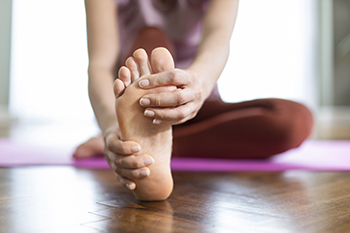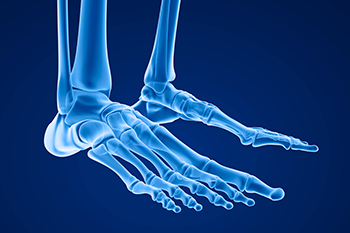
Ankle sprains are among the most common musculoskeletal injuries, occurring when the ligaments that support the ankle stretch or tear. There are different types of ankle sprains, categorized based on the severity of ligament damage and the direction of the injury. The most common type is an inversion sprain, where the foot rolls inward and strains the outer ligaments. Eversion sprains, which are less frequent, occur when the foot rolls outward. High ankle sprains involve the ligaments above the ankle joint and are typically more serious. Causes of ankle sprains include sudden twists, slips, or impacts during activities like sports, walking on uneven surfaces, or simply mis-stepping. If you have suffered an ankle sprain, it is suggested that you consult a podiatrist who can accurately examine the injury and offer appropriate treatment solutions.
Ankle sprains are common but need immediate attention. If you need your feet checked, contact Sarah Urton, DPM from Kitsilano Foot and Ankle Clinic. Our doctor can provide the care you need to keep you pain-free and on your feet.
How Does an Ankle Sprain Occur?
Ankle sprains take place when the ligaments in your ankle are torn or stretched beyond their limits. There are multiple ways that the ankle can become injured, including twisting or rolling over onto your ankle, putting undue stress on it, or causing trauma to the ankle itself.
What Are the Symptoms?
- Mild to moderate bruising
- Limited mobility
- Swelling
- Discoloration of the skin (depending on severity)
Preventing a Sprain
- Wearing appropriate shoes for the occasion
- Stretching before exercises and sports
- Knowing your limits
Treatment of a Sprain
Treatment of a sprain depends on the severity. Many times, people are told to rest and remain off their feet completely, while others are given an air cast. If the sprain is very severe, surgery may be required.
If you have suffered an ankle sprain previously, you may want to consider additional support such as a brace and regular exercises to strengthen the ankle.
If you have any questions please feel free to contact our office located in Vancouver, BC . We offer the newest diagnostic and treatment technologies for all your foot and ankle needs.

Toenails can fall off for a number of reasons, including injury, infection, or underlying health issues. Trauma, such as stubbing a toe or dropping something heavy on it, may cause blood to collect under the nail, called a subungual hematoma, which can lead to toenail loss. Fungal infections can also weaken the nail, causing it to become discolored, thickened, and brittle until it detaches from the nail bed. Skin conditions like psoriasis may damage the nail matrix and lead to nail separation. Certain health conditions, like diabetes or poor circulation from peripheral artery disease, can limit blood flow to the feet and make the nails more prone to falling off. Certain medications may affect nail growth and strength. A podiatrist can examine the affected nail and recommend proper treatment, including antifungal care, or monitoring circulation. If you have problematic toenails, it is suggested that you schedule an appointment with a podiatrist for appropriate treatment.
Toe pain can disrupt your daily activities. If you have any concerns, contact Sarah Urton, DPM of Kitsilano Foot and Ankle Clinic. Our doctor can provide the care you need to keep you pain-free and on your feet.
What Causes Toe Pain?
Most severe toe pain is caused due to a sports injury, trauma from dropping something heavy on the toe, or bumping into something rigid. Other problems can develop over time for various reasons.
Toe pain can be caused by one or more ailments. The most common include:
- Trauma
- Sports injury
- Wearing shoes that are too tight
- Arthritis
- Gout
- Corns and calluses
- Hammertoe
- Bunions
- Blisters
- Ingrown toenails
- Sprains
- Fractures (broken bones)
- Dislocations
When to See a Podiatrist
- Severe pain
- Persistent pain that lasts more than a week
- Signs of infection
- Continued swelling
- Pain that prevents walking
Diagnosis
In many cases the cause of toe pain is obvious, but in others, a podiatrist may want to use more advanced methods to determine the problem. These can range from simple visual inspections and sensation tests to X-rays and MRI scans. Prior medical history, family medical history, and any recent physical traumatic events will all be taken into consideration for a proper diagnosis.
Treatment
Treatments for toe pain and injuries vary and may include shoe inserts, padding, taping, medicines, injections, and in some cases, surgery. If you believe that you have broken a toe, please see a podiatrist as soon as possible.
If you have any questions please feel free to contact our office located in Vancouver, BC . We offer the newest diagnostic tools and technology to treat your foot and ankle needs.

The foot is a complex structure made up of many bones that work together to support movement, balance, and weight-bearing. It is divided into three main regions known as the hindfoot, midfoot, and forefoot. The hindfoot includes the heel bone and the bone that connects to the ankle, which help absorb shock during walking. The midfoot contains a group of bones that form the arch and provide stability and flexibility. The forefoot includes the long bones of the foot and the toes, which play an essential role in propulsion during walking. Arches in the foot distribute weight evenly and help adapt to different surfaces. Together, these bones and structural elements create a strong, adaptable foundation. If you have foot pain, it is suggested that you consult a podiatrist who can treat various foot conditions.
If you have any concerns about your feet, contact Sarah Urton, DPM from Kitsilano Foot and Ankle Clinic. Our doctor can provide the care you need to keep you pain-free and on your feet.
Biomechanics in Podiatry
Podiatric biomechanics is a particular sector of specialty podiatry with licensed practitioners who are trained to diagnose and treat conditions affecting the foot, ankle and lower leg. Biomechanics deals with the forces that act against the body, causing an interference with the biological structures. It focuses on the movement of the ankle, the foot and the forces that interact with them.
A History of Biomechanics
- Biomechanics dates back to the BC era in Egypt where evidence of professional foot care has been recorded.
- In 1974, biomechanics gained a higher profile from the studies of Merton Root, who claimed that by changing or controlling the forces between the ankle and the foot, corrections or conditions could be implemented to gain strength and coordination in the area.
Modern technological improvements are based on past theories and therapeutic processes that provide a better understanding of podiatric concepts for biomechanics. Computers can provide accurate information about the forces and patterns of the feet and lower legs.
Understanding biomechanics of the feet can help improve and eliminate pain, stopping further stress to the foot.
If you have any questions please feel free to contact our office located in Vancouver, BC . We offer the newest diagnostic and treatment technologies for all your foot and ankle needs.

